Family : Tytonidae

Text © Dr. Gianfranco Colombo

English translation by Mario Beltramini
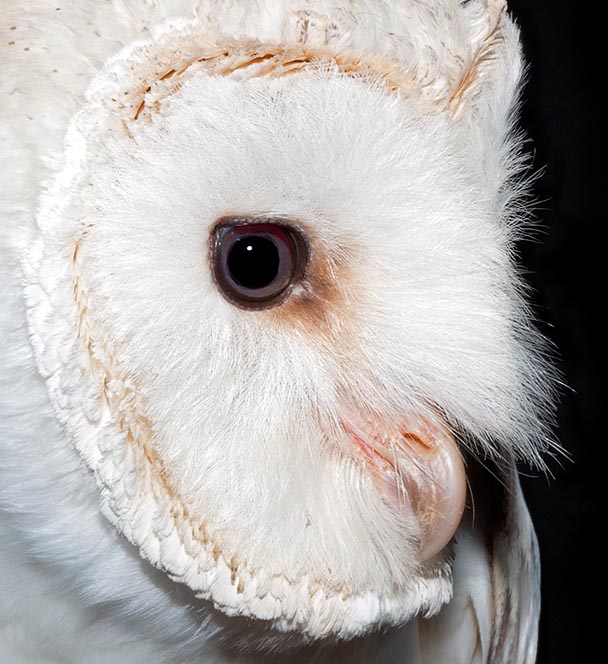
Unmistakable but with various races, for some subspecies or even species despite the minimal differences, Tyto alba is one of the most elegant night raptors present in all the world, but Antarctica © Giuseppe Mazza
A small family grouping only two genera the Phodilus and the Tyto, birds with characteristics particular and well distinguishable from their similars and classified in their turn in a reduced number of species that often, as is the case for the Tyto, result having been previously known as subspecies and then revaluated at superior level during decades of studies and debates.
Still now the number of subspecies, evaluated in about thirty, stands at the centre of heated debates on the necessity or not of possible their revaluations or reclassifications.
The 13 species of Tyto now recognized are practically similar to each other unless small and more or less evident differences of colour of the livery or of size or from the different habits or for the environment frequented.
Trying to list the many nicknames given to this bird is by sure impossible, considered its ample notoriety and the extremely vast range where it is present, an immense territory practically covering all five continents.
The ghostly night colour that renders it unmistakable, its singing totally different from any other strigiform, the bad reputation acquired from medieval traditions or local superstitions and its close cohabitation with human activities, have contributed in increasing the fame of this nice owl. White owl, demon owl, church owl, ghost owl, barn owl, golden owl, death owl, hissing owl, monkey-faced owl, in short, an interminable list of folkloric and anecdotal names that have distinguished this bird all over the world.
It is not clear why this raptor is so known an called seen that it is a nocturnal animal often invisible to the many, the fact is that its name is present since ever in the tradition and in the memory of the populations that are in touch with it. Same nicknames often used in a negative sense, other times affectionately. The same Italian name Barbagianni, so much affectionate and sympathetic, has not yet clear origins and has equally conflicting interpretations. Barbagianni is said to come from the composition of the term “barba” = uncle in North-East Italy and from the proper noun Giovanni (John), this to indicate the familiarity of this bird but in the meantime barbagianni is used in a negative sense to indicate silly and nosy elderly people and by now stunned by the age. Actually, the litteral derivation leads to think that the name barbagianni comes from the Latin “barbagena” union of the terms “barba”=beard and of “gena”=cheek to indicate the bearded face of this bird. In the past centuries the barn owl has always been considered as an evil bird, belonging to the devil and witches world and fingered, as happened with many other strigiforms, as harbinger of doom for the unfortunate who were in contact with it.
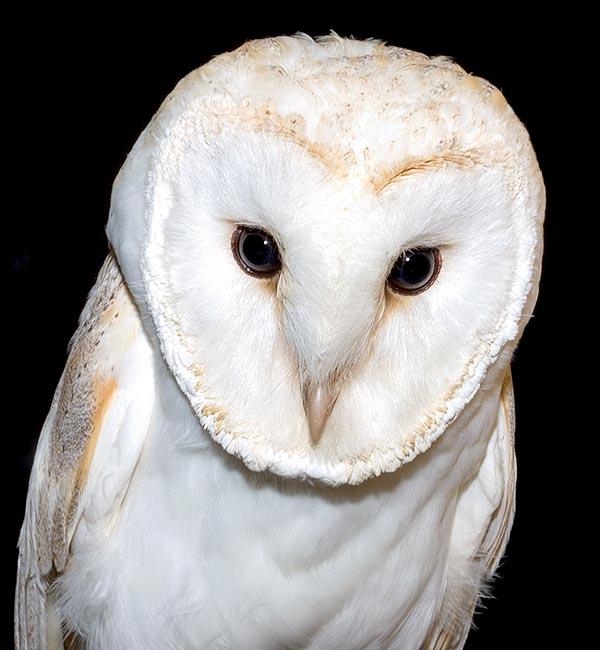
The face is framed by a sort of beard, like the Italian name barbagianni hints, that is Gianni beard. The facial discs collect like parables, due to unparalleled hearing, the preys minimal noises © Giuseppe Mazza
Its absolutely silent flight and the white ghostly colour added to the usual frequentation of sites such as graveyards and old churches, caused during the accidental night impacts with the human being, real psychological traumatisms.
Furthermore it is not to be forgotten that this bird signals its presence with sounds, whistles, hisses and fairly gloomy cackles, well different from the singing of any other consimilar. Even today, to see it suddenly by night crossing the road illuminated by the lights of our cars, arouses in us that strange feeling that once was translated in terrible doomy omens.
Only recently after a period stupidly moved by archaic superstitions, the countrymen have understood its utility and have begun to consider it as beneficial to their activity and to give it that well deserved protection missed in the centuries, seen the enormous quantity of rodents that this raptor is capable to catch. When this bird is present in a barn is the best guarantee for the limitation of the number of the rodents.
The etymology of the scientific name is quite simple, Tyto comes from the Greek “tuto” = owl, old onomatopoeic term and alba from the homonymous Latin term “albus” = white.
Here are some of the most common vulgar names, seen the enormity of their number: Barn Owl in English, Effraie des clochers or Dame blanche in French; Schleiereule in German; Lechuza de los campanarios in Spanish; Coruja das torres or Coruja catòlica or Rasga mortalha in Portuguese.
Along with the Eurasian-eagle owl (Bubo bubo) and the Snowy owl (Nyctea scandiaca), is the most used strigiform in the falconry.
Zoogeography
Among the nocturnal raptors, the barn owl is the bird with the most ample range, in fact it lives in all continents, but Antarctica. It is present from North America to Australia, from North Europe to the extreme African south, from the north to the extreme south of America and in the islands of eastern Pacific. Its range is so vast that it is met even in the remote Galapagos Islands. It absolutely avoids the high altitude mountains, the desert areas and the vast and cold plains of the north of the continents.
Oddly enough, in Asia it stops south to the great mountain ranges of the Karakorum and Himalaya, reducing its presence to the tropical Indo-Malaysian area. Same area is limited on the west by the Ural mountains althoug having good populations in the European Russia placed at the same latitude. It covers the whole Middle East and the Arabian Peninsula. It is therefore to be considered as a bird not loving the cold and is surely conditioned by the thickness of the winter snow cover and by the temperatures to which is subject the territory where it lives.
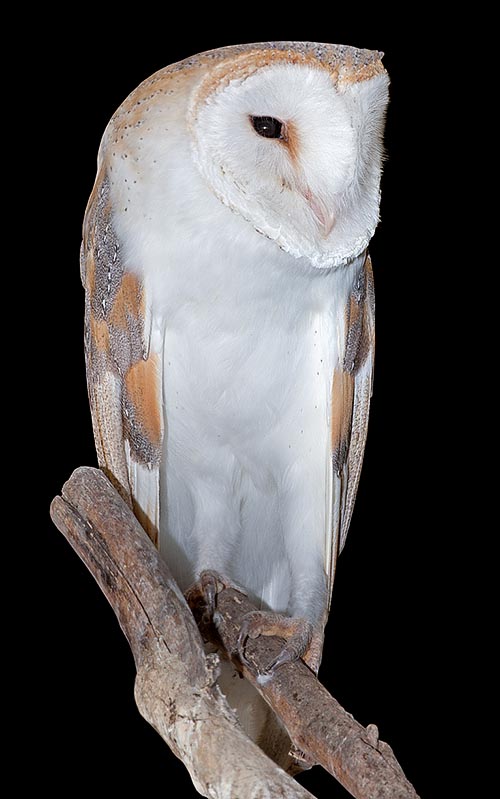
It hunts all night, with silent flight or swoop from branch, small rodents. It's the raptor who despite the modest weight of 300-400 g eats more meat: even 1000 mice per year © Giuseppe Mazza
In some cases, in the tropical zones, we can observe short seasonal movements due to the succession of rains.
The European population has undergone a dramatic reduction during the last decades until reaching in some areas a reduction very close to the extinction.
The modernization of the agriculture and the reduction of the country old-style isolated buildings, with granaries and barns and covers with beams and niches that gave safe haven to these birds, have been the main causes of their strong reduction.
Moreover, the fury with pesticides and poisoned bait to struggle against the small rodents has contributed heavily in the reduction of their number in our industrialized zones.
It is presently placed among the endangered birds and is strongly protected.
Ecology-Habitat
The barn owl lives mainly the rural areas, grassy plains with presence of thorny bushes, rows of trees and small groves, farms with vast cultivations, locations where it easily finds the food.
It almost never exceeds the 2000 metres of altitude and rarely the 3000 in the tropical areas, this to mean the necessity to enjoy always moderate temperatures and to avoid the strong cold.
It is a purely nocturnal bird that begins the hunting activity in the late evening leaving the shelter only at dark advanced though it has been noted that in the north of its range often is observed hunting already by dusk and at times also in late afternoon especially during the winter time or the nidification period.
In the Mediterranean it has kept linked to the nocturnal habits and only if accidentally mobbed by some disturber, it is seen fluttering by day looking for a new shelter.
Its preferred sites where to spend the day are the old barns, the abandoned or little disturbed farmsteads, the belfries of the country towns, old ruins and now, temporarily during the winter, industrial sheds. In this last case often falls victim of some shot having been unknowlingly guilty of having activated anti-intruders alarm systems in some industrial shed.
The barn owl is an exceptional hunter of small rodents. It is thought that it can catch more than 1000 mice during one year and this renders it one of the major consumers of these noxious animals. In the ratio between weight of predator and weight of the victims, the barn owl holds the record among the highest consumers in the avian world. For this reason it is nowadays highly considered and protected and, in order to increase its number in the attempt to tak it back to the original consistencies, have been launched campaigns of positioning of artificial nests in the sites previously inhabited by this raptor.
Its hunt consists mainly in flying over the chosen areas, with a light flight and with ample and deep beats of wings but with a softness and a so limited effort to remind the twirling of a large butterfly. Its flight is absolutely silent as the feathers of the remiges, as often is the case in the strigiforms, are equipped with barbules on both barbs, such to cancel the noise caused by the friction of the air. It hunts also from standstill in total darkness, taking advantage of the asymmetry of the auricular holes that allows to determine with absolute precision the position of the chosen victim.
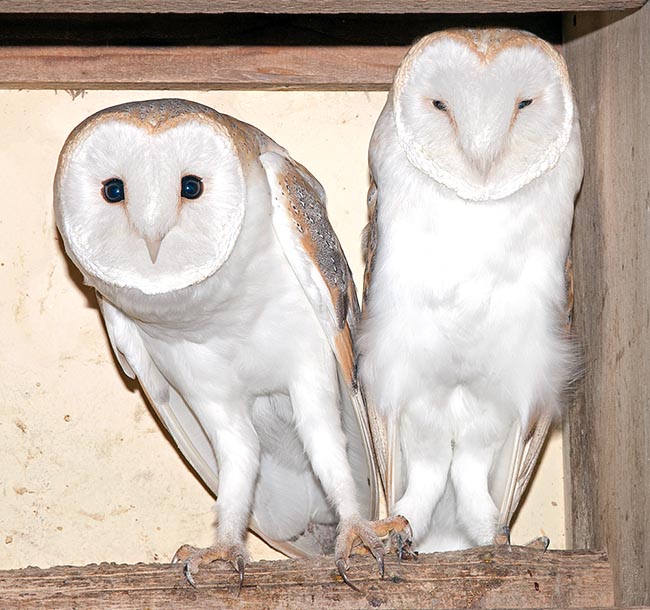
Nests and spends all day sleepy in old granaries, abandoned country houses, belfries, ruins and at times in hollow trees. The putrefying leftovers, close to the wads, emit a strong unbearable cadaveric stench © Giuseppe Mazza
It mainly hunts small rodents but does not disdain leverets and bunnies, frogs, lizards and big insects. Often, in the nights rich of preys, the surplus of the hunt is carried into the den, as stock for periods of poor availability.
It does not attack small domestic animals or poultry, consequently it is not, in any way, harmful to the human activities.
It is not too territorial limiting to a small hunting space where practically spends the whole life.
Same dimensions in the range are maintained by the partner during the winter separation period and then is united when the time of the nidification comes.
Morpho-physiology
The barn owl has a wonderful livery contrasted by a bright white on the lower part of the body and of the underwing and an alar cover orange yellow almost golden that expands on the whole back and on the head.
This cover is in its turn mottled with stripes and black, white or grey small points that give a wonderful and unmistakable variegation. The very white underpart is at times slightly black dotted or with also orange spots. The diversity of shades in the livery has given orign to the classification of a good number of subspecies. During the flight it appears totally white whence the various names given in the popular tradition.
The face is completely surrounded by a blackish line formed by short feathers that delimits a perfect and symmetric facial circle, totally white and that forms, in its turn, with the central tufts where the beak is hidden, two heart-shaped oval concave discs where are placed the big black frontal eyes. The gaze of the barn owl is definitely bewitching.
It has fairly big legs, very elongated and covered by a short white small down, with particularly big and powerful nails. The legs appear even disproportionate to the size of the animal. A proof of evidence of these big tools and of their power, is easily verifiable when, being in a defence situation, this bird turns upside down stretching towards the unaware intruder two powerful clawed feet, terrible in the effects and in the dissuasion. The juveniles are much similar to the adults with a less marked distinction of the colour tones and of the various shades. It has considerable size considered a total length between the 30 and 40 cm with an about 90 cm winspan and a weight quite variable in the seasons between the 300 and the 400 g.
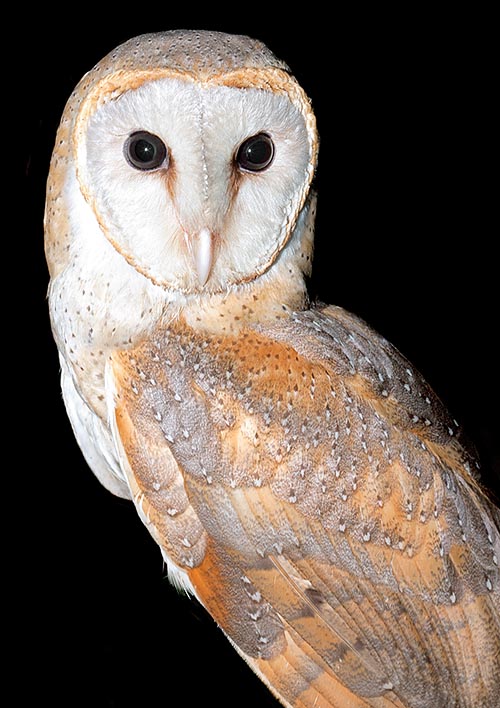
The back colour is splendid. Wrongly hunted by men, it frees him from mice and never attacks domestic animals. Lays even 10 elliptic eggs hatched by the female © G. Mazza
The barn owl does not hoot and does not emit the usual cry of the owls or of the screetch-owl but produces, especially in the young, hisses like the most dangerous snakes and terrifying shrieks that freeze the night.
An unmistakable sound, strong and very penetrating that may be heard from quite far away.
Also the nesting site has its sensory characteristics. The cadaveric reek getting out from their dens is one of the most evident indications of their presence. Actually, their shelters are coverd by putrefying preys and food scraps besides the big black and glossy wads that are vomited after each meal.
Reproductive Biology
The barn owl is monogamous and remains with the same partner for the whole life, replacing it only in case of demise.
The nidification occurs in various periods of the year depending on the occupied area. In Europe it takes place in late spring with precocious peaks in February and often when a good availability of prey is found, it does two broods.
It usually nidifies in old buildings, in the barns, in the granaries and when available, also in hollows of old trees, modality more frequented in more humid and rainy areas.
Usually it prefers uninhabited ceilings where the chicks can freely romp about during their long stay in the nest, taking refuge, if the case, in the smallest and narrowest spaces where they are hard to reach.
At times they content of small holes at the limit of the habitability, where with high difficulty the young, now grown up, can barely coexist.
It usually lays 3/7 white eggs, at times even more than 10, elliptic and not particularly round like its similars. The hatching lasts about 5 weeks and is done only by the female.
The chicks come to life with a soft and whitish down that makes them look like big cotton balls and that they gradually lose during the growth that may be completed after about 8/10 weeks. They are however cared for long periods even after having left the nest. They reach the sexual maturity before completing the first year and have a very reduced prospect of survival in nature, in particular during the first months of independence whilst barely reaches the twenty years in captivity.
The nests are often predated, outside the European continent by particularly greedy arboreal animals, such as the raccoons in North America, the viverrids in Africa and some monkeys and the mustelids in south-eastern Asia whilst in our continent they are mainly sparrow hawks, eagle owls and buzzards. The worst enemy is, anyway, the human persecution that often goes beyond the common sense and forgets the basic principles of the love for the nature. The effigy of the barn owl is represented on the coins of Lithuania.
Synonyms
Strix alba Scopoli, 1769; Strix praticola Bonaparte, 1838; Tyto delicatula Gould, 1837.
→ To appreciate the biodiversity within the birds of prey and find other species please click here.
